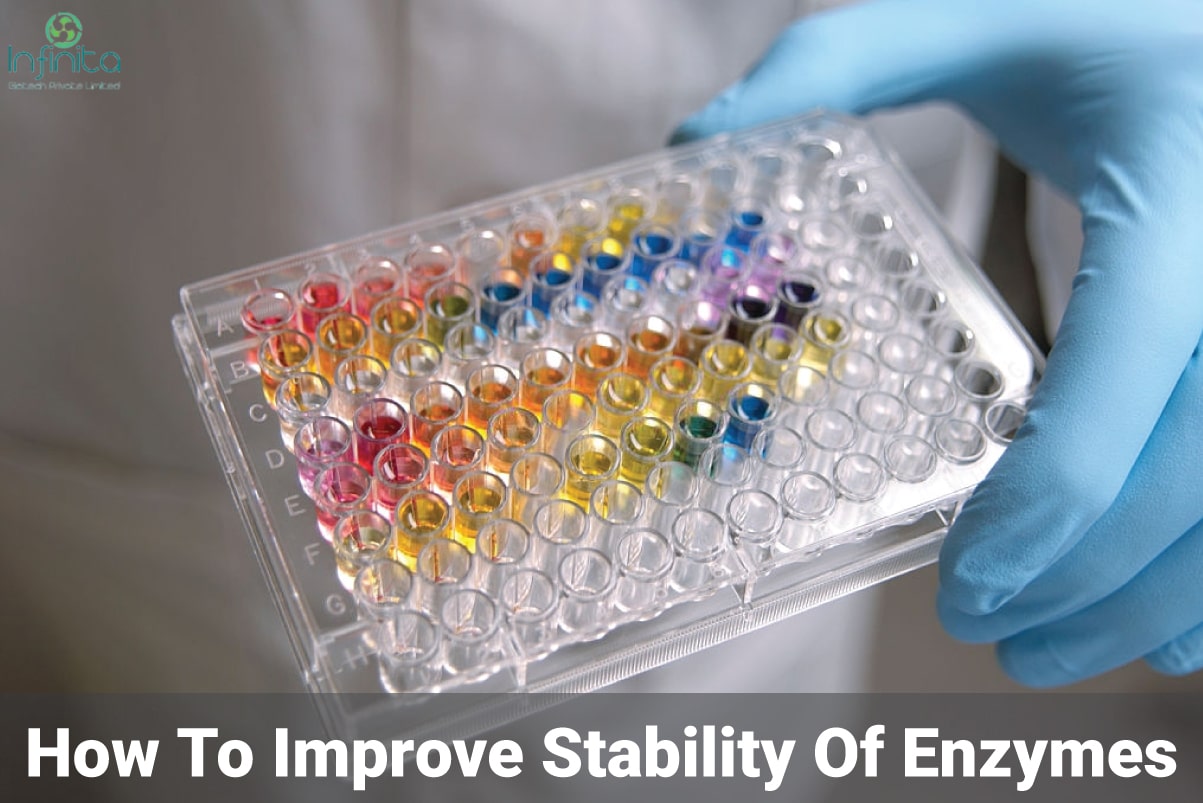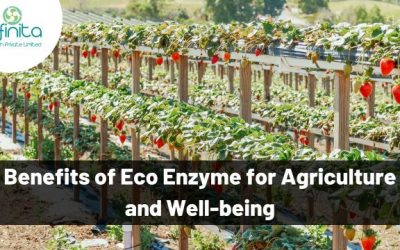
How To Improve The Stability Of An Enzyme
Strategies To Improve The Stability Of An Enzyme
The stability of enzymes is extremely important in different applications. Enzymes are useful in many fields like biocatalysis, analytical chemistry, food processing, environmental treatment, detergent manufacture etc. In these fields, retaining the biological activity of the enzyme molecule is vital and this is based on the stabilisation of the biological structure of the enzyme. Enzyme stability is a crucial think about crucial whether or not associate degree application of biocatalysis are commercially productive. Many enzymes start denaturing when they are exposed to extreme heat, pH or proteases. In recent years, a lot of research has focused on improving enzyme behaviour in the conditions where they will be used. A special focus has been on the increase in their thermal stability. If heat resistant enzymes are produced then enzymatic reactions could be carried at higher temperatures. This would lead to an increase in the conversion rates, substrate solubility and decrease the risk of microbial growth in the medium.
There Are Mainly Two Types Of Stability:
- Storage or Shelf Stability: This is the stability of enzymes once keep as a dehydrated preparation, an answer or immobilised. It is based on the retention of activity over time.
- Operational Stability: This is the stability of enzymes which is based on the retention of enzyme activity when in use.
Thermal Enzyme Stability:
A strategy that can be used to determine the thermal stability of an enzyme is determining the half lifetime at a chosen temperature. This provides data about the residual activity of an enzyme which is a crucial parameter in industrial application od biocatalysts. Thermal stability in an enzyme can be achieved by enzyme surface modification. Hydrophilic and hydrophobic balance appears to have a major role in the thermal stability of an enzyme. Non-polar amino acids are present on macromolecule surfaces in hydrophobic teams.
The distribution of those cluster determines properties like solubility, activity, specificity and stability. Therefore modifying the protein surface characteristics through chemical binding is a good way to enhance the performance of enzymes.
There Are Several Strategies That Have Been Proposed To Improve The Stability Of Enzymes.
1. Use Of Soluble Additives:
The polypeptide chain in an enzyme is folded and in doing so important functional groups are brought together in the active site. However, confirmation changes may disrupt this arrangement which leads to the loss of enzymatic activity. The addition of soluble additives has an adverse effect on this unfolding process. Additives are substances like substrates and similar ligands, polymers, specific and non-specific ion species and small uncharged organic molecules.
2. Immobilisation:
An immobilised enzyme is an enzyme which is combined with an inert and insoluble material, for example, calcium alginate. Immobilising an enzyme provides greater resistance to an extreme condition like pH or temperature. It also holds the enzyme in place throughout the reaction so that they can easily separate from the product and used in reaction again. This is a very efficient process and is widely used in industries that employ enzyme catalysed reactions.
There are many ways to immobilise an enzyme:
- Affinity-tag binding: Enzymes can be immobilised to a porous surface using either covalent or non-covalent protein tags. This technology was invented for purifying proteins.
- Adsorption on alginate beads, matrix or glass: In this process, the enzyme is attached to the outside of a non-reactive material. Generally, this method is the slowest because adsorption is not a chemical reaction. This can also lead to the blocking of the active site by the enzyme and hence lead to a decrease in enzyme activity.
- Entrapment: In this process, the enzyme is trapped inside insoluble beads or microspheres, for example, calcium alginate beads. The disadvantage of this process is that it hinders the arrival of the substrate ad the exit of the products.
- Cross-linkage: This process includes the covalent bonding of enzyme molecules to create a matrix that only consists of enzymes. This ensures that the active site is not covered by the binding site. However, covalent bonds are inflexible which prevents the exhibition of self-healing properties of chemoadsorbed self-assembled monolayer. This effect can be reduced with the help of spacer molecules like poly(ethanol glycol).
- Covalent bond: This approach involves the covalent binding of the enzyme to insoluble support like silica gel. This process has the lowest protein leakage during catalysis because it provides the strongest enzyme/support interaction.
Apart from increasing stability, immobilised enzymes are extremely vital to commercial usage because they decrease the expenses and possess benefits to the processes and reactions.
- Convenience: Very small amounts of protein are dissolved in the reaction, which leads to easier workups. Furthermore, when the reaction is complete the reaction mixture generally just contains the solvent and the reaction products.
- Economy: It becomes easier to recycle the biocatalyst because the immobilised enzyme can easily be removed from the reaction. In the production of lactose-free milk, this benefit comes in handy because the milk can be drained from the container only leaving the enzyme. This enzyme is then ready to be used for the next batch.
3. Protein Engineering:
Also called enzyme engineering is the process of modifying an enzyme’s structure and therefore its function or altering the catalytic activity of isolated enzymes. This is done to produce new metabolites, to allow new catalysed pathways for reactions to occur and to transform some compounds into others, and to stabilise the enzyme. This is done in an enzyme reactor which has a vessel containing a reactional medium. The reactional medium is used to conduct the desired conversion using enzymes. The amino acids are modified using substitution through site-directed mutagenesis. This produces mutants with better physical and biochemical properties. Site-directed mutagenesis changes any amino acid residue into enzyme for any amino acid. It is possible to change a specific amino acid into an unnatural amino acid analogue.
4. Chemical Modification:
In this process, the amino acid residues of proteins are chemically modified by using polymers like aldehydes, imidoesters and anhydrides. This process requires reactive amino acids which can be basic, acidic, alcoholic, aromatic and containing sulphur. There are three ways through which chemical modification is done.
- Differential labelling method: This a two-step modification which selectively modifies the target amino acid residue located at the substrate of the analogue binding site. In the first step, specific protection of the target residue from the chemical modification is done by taking advantage of the specific binding substrate or the analogue to the active site. In the second step, the intact target residue is labelled.
- Affinity labelling method: This involves the selective modification of the target residue using reagent consisting of a reactive group to the target amino acid residue and an affinity group specific to the site where the target residue exists.
- Kinetic discrimination method: This process analyses the state of each amino acid residue and monitors the reaction rate of the modification.
In conclusion, enzyme stability is extremely important for commercial applications because it increases the shelf life of the enzyme and operational stability of the enzyme. Stability of enzymes is applied in the food processing industry, detergent industry, and have environmental applications like treating organic pollutants and many other processes.
Related Articles
The Basics of Soil Stabilization: An Introduction
What is Soil Stabilization? Definition: Have you ever wondered how builders manage to create rock-solid foundations for structures, even on unstable grounds? That's where soil stabilization becomes critical. At its core, soil stabilization refers to the process of...
Bio Enzyme Uses and Their Applications

How To Improve The Stability Of An Enzyme
Strategies To Improve The Stability Of An Enzyme
The stability of enzymes is extremely important in different applications. Enzymes are useful in many fields like biocatalysis, analytical chemistry, food processing, environmental treatment, detergent manufacture etc. In these fields, retaining the biological activity of the enzyme molecule is vital and this is based on the stabilisation of the biological structure of the enzyme. Enzyme stability is a crucial think about crucial whether or not associate degree application of biocatalysis are commercially productive. Many enzymes start denaturing when they are exposed to extreme heat, pH or proteases. In recent years, a lot of research has focused on improving enzyme behaviour in the conditions where they will be used. A special focus has been on the increase in their thermal stability. If heat resistant enzymes are produced then enzymatic reactions could be carried at higher temperatures. This would lead to an increase in the conversion rates, substrate solubility and decrease the risk of microbial growth in the medium.
There Are Mainly Two Types Of Stability:
- Storage or Shelf Stability: This is the stability of enzymes once keep as a dehydrated preparation, an answer or immobilised. It is based on the retention of activity over time.
- Operational Stability: This is the stability of enzymes which is based on the retention of enzyme activity when in use.
Thermal Enzyme Stability:
A strategy that can be used to determine the thermal stability of an enzyme is determining the half lifetime at a chosen temperature. This provides data about the residual activity of an enzyme which is a crucial parameter in industrial application od biocatalysts. Thermal stability in an enzyme can be achieved by enzyme surface modification. Hydrophilic and hydrophobic balance appears to have a major role in the thermal stability of an enzyme. Non-polar amino acids are present on macromolecule surfaces in hydrophobic teams.
The distribution of those cluster determines properties like solubility, activity, specificity and stability. Therefore modifying the protein surface characteristics through chemical binding is a good way to enhance the performance of enzymes.
There Are Several Strategies That Have Been Proposed To Improve The Stability Of Enzymes.
1. Use Of Soluble Additives:
The polypeptide chain in an enzyme is folded and in doing so important functional groups are brought together in the active site. However, confirmation changes may disrupt this arrangement which leads to the loss of enzymatic activity. The addition of soluble additives has an adverse effect on this unfolding process. Additives are substances like substrates and similar ligands, polymers, specific and non-specific ion species and small uncharged organic molecules.
2. Immobilisation:
An immobilised enzyme is an enzyme which is combined with an inert and insoluble material, for example, calcium alginate. Immobilising an enzyme provides greater resistance to an extreme condition like pH or temperature. It also holds the enzyme in place throughout the reaction so that they can easily separate from the product and used in reaction again. This is a very efficient process and is widely used in industries that employ enzyme catalysed reactions.
There are many ways to immobilise an enzyme:
- Affinity-tag binding: Enzymes can be immobilised to a porous surface using either covalent or non-covalent protein tags. This technology was invented for purifying proteins.
- Adsorption on alginate beads, matrix or glass: In this process, the enzyme is attached to the outside of a non-reactive material. Generally, this method is the slowest because adsorption is not a chemical reaction. This can also lead to the blocking of the active site by the enzyme and hence lead to a decrease in enzyme activity.
- Entrapment: In this process, the enzyme is trapped inside insoluble beads or microspheres, for example, calcium alginate beads. The disadvantage of this process is that it hinders the arrival of the substrate ad the exit of the products.
- Cross-linkage: This process includes the covalent bonding of enzyme molecules to create a matrix that only consists of enzymes. This ensures that the active site is not covered by the binding site. However, covalent bonds are inflexible which prevents the exhibition of self-healing properties of chemoadsorbed self-assembled monolayer. This effect can be reduced with the help of spacer molecules like poly(ethanol glycol).
- Covalent bond: This approach involves the covalent binding of the enzyme to insoluble support like silica gel. This process has the lowest protein leakage during catalysis because it provides the strongest enzyme/support interaction.
Apart from increasing stability, immobilised enzymes are extremely vital to commercial usage because they decrease the expenses and possess benefits to the processes and reactions.
- Convenience: Very small amounts of protein are dissolved in the reaction, which leads to easier workups. Furthermore, when the reaction is complete the reaction mixture generally just contains the solvent and the reaction products.
- Economy: It becomes easier to recycle the biocatalyst because the immobilised enzyme can easily be removed from the reaction. In the production of lactose-free milk, this benefit comes in handy because the milk can be drained from the container only leaving the enzyme. This enzyme is then ready to be used for the next batch.
3. Protein Engineering:
Also called enzyme engineering is the process of modifying an enzyme’s structure and therefore its function or altering the catalytic activity of isolated enzymes. This is done to produce new metabolites, to allow new catalysed pathways for reactions to occur and to transform some compounds into others, and to stabilise the enzyme. This is done in an enzyme reactor which has a vessel containing a reactional medium. The reactional medium is used to conduct the desired conversion using enzymes. The amino acids are modified using substitution through site-directed mutagenesis. This produces mutants with better physical and biochemical properties. Site-directed mutagenesis changes any amino acid residue into enzyme for any amino acid. It is possible to change a specific amino acid into an unnatural amino acid analogue.
4. Chemical Modification:
In this process, the amino acid residues of proteins are chemically modified by using polymers like aldehydes, imidoesters and anhydrides. This process requires reactive amino acids which can be basic, acidic, alcoholic, aromatic and containing sulphur. There are three ways through which chemical modification is done.
- Differential labelling method: This a two-step modification which selectively modifies the target amino acid residue located at the substrate of the analogue binding site. In the first step, specific protection of the target residue from the chemical modification is done by taking advantage of the specific binding substrate or the analogue to the active site. In the second step, the intact target residue is labelled.
- Affinity labelling method: This involves the selective modification of the target residue using reagent consisting of a reactive group to the target amino acid residue and an affinity group specific to the site where the target residue exists.
- Kinetic discrimination method: This process analyses the state of each amino acid residue and monitors the reaction rate of the modification.
In conclusion, enzyme stability is extremely important for commercial applications because it increases the shelf life of the enzyme and operational stability of the enzyme. Stability of enzymes is applied in the food processing industry, detergent industry, and have environmental applications like treating organic pollutants and many other processes.
0 Comments
Submit a Comment
You must be logged in to post a comment.
CATEGORIES
- Agriculture Enzymes
- Animal Feed Enzymes
- Brewery Enzymes
- Cellulase Complex Enzymes For Cellulosic Ethanol
- Covid – 19
- Detergent Enzymes
- Disinfectants
- Distillery Enzymes
- Enzymes
- Enzymes for Biodiesel
- Enzymes For Ceramic Industry
- Enzymes for Cosmetics
- Enzymes for Crude Oil Spill Remediation
- Enzymes For Hydrolysis Of Gel Used In Crude Oil Extraction
- Enzymes for Malt
- Enzymes for soil stabilization
- Food and Beverage Enzymes
- Juice Extraction Enzymes For Wine
- Pharmaceutical Enzymes
- Pulp and Paper Enzymes
- Starch Processing Enzymes
- Sugar Processing Enzymes
- Textile Enzymes
- Wastewater Treatment Enzymes
The Basics of Soil Stabilization: An Introduction
What is Soil Stabilization? Definition: Have you ever wondered how builders manage to create rock-solid foundations for structures, even on unstable grounds? That's where soil stabilization becomes critical. At its core, soil stabilization refers to the process of...
Bio Enzyme Uses and Their Applications
Benefits of Eco Enzyme for Agriculture and Well-being
In today's world, where sustainable practices and holistic well-being are gaining prominence, the eco enzyme has emerged as a remarkable solution with numerous benefits for both agriculture and overall well-being. This powerful organic concoction offers a multitude of...




0 Comments